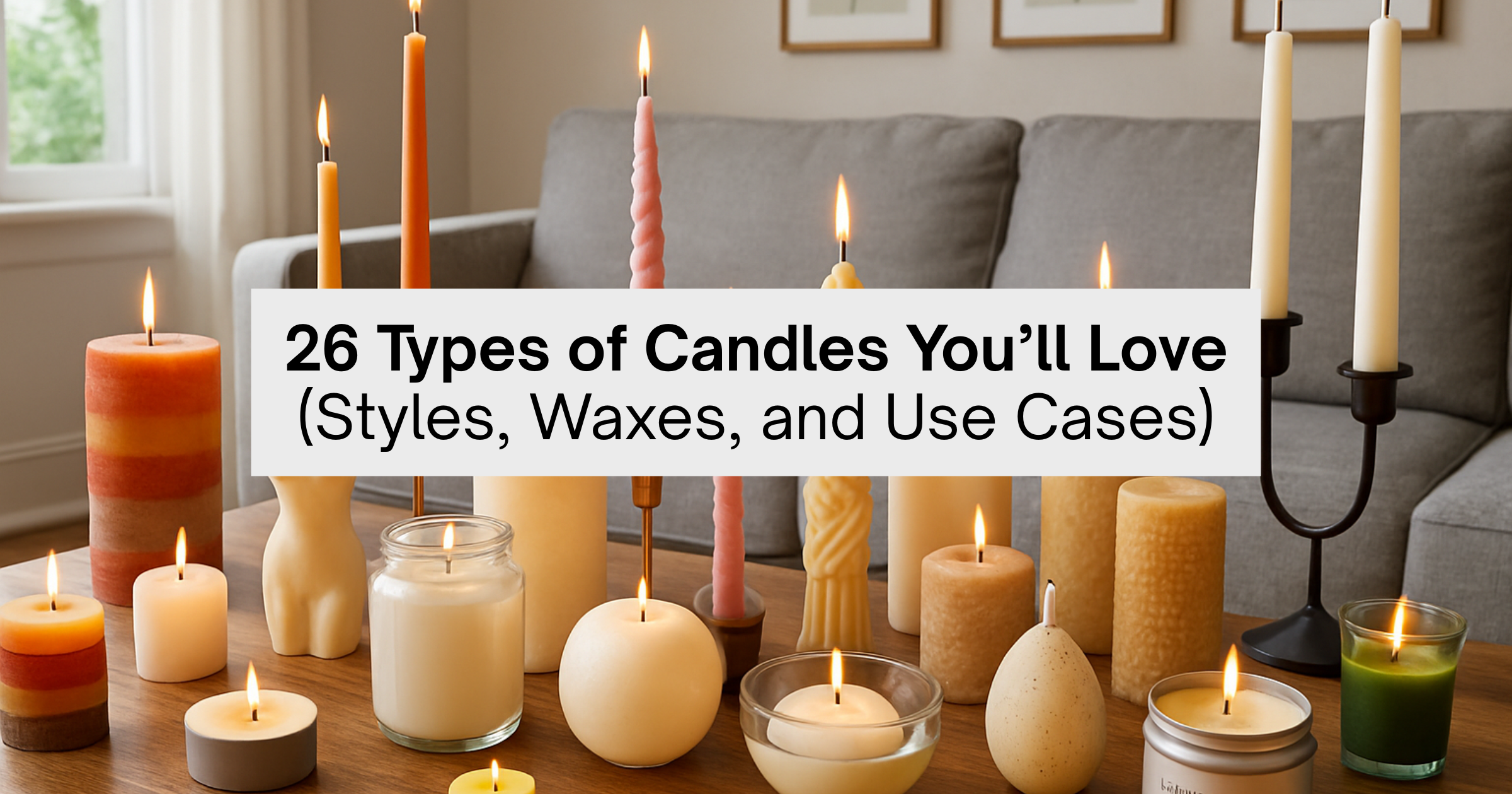No products in the cart.
26 Types of Candles You’ll Love (Styles, Waxes, and Use Cases)

Candles do more than decorate a space. They change the mood, mark special moments, and bring comfort through scent and warmth.
From quiet evenings to festive gatherings, a single flame can shift how a room feels. Across traditions and modern spaces, candles continue to hold a place that’s both personal and purposeful.
This guide breaks down the many types of candles you’ll see in shops, spas, homes, and brands.
You’ll learn exactly what candles are made of, how wax and wick choices change the way a candle burns, and how to choose the right type based on purpose, scent, and setting.
Each kind serves a different goal—and knowing those details can help you pick better, burn cleaner, and style smarter.
What Are Candles Made Of?
Candles are made of wax, a wick, and sometimes fragrance oils. Common waxes include soy, coconut, and paraffin, while wicks are usually cotton or wood. The type and quality of these materials affect burn time, scent, and how cleanly the candle burns.
Understanding what goes into a candle isn’t just trivia—it’s the foundation of making high-quality candles that burn beautifully. Wax is more than just “the stuff that melts”; it’s the heart of the candle, influencing burn speed, smoke output, and scent release.
Soy and coconut wax, for example, are slow-burning and clean, making them favorites for artisanal candle makers. Paraffin, while more affordable, tends to produce more soot but can hold vibrant colors and strong fragrances.
The wick, though small, is the candle’s lifeline. Cotton wicks give a steady, traditional flame, while wooden wicks offer a rustic crackle and a modern, aesthetic appeal. Pairing the right wick with the right wax isn’t guesswork—it’s an art form that determines whether your candle tunnels, flickers, or burns evenly to the edge.
Fragrance oils, when blended skillfully, can transform a simple candle into a sensory experience. Whether it’s lavender for relaxation or citrus for energy, the type and concentration of scent impact not only the aroma but also the candle’s throw—the reach of its fragrance in a space.
When you understand how these elements work together, candle making stops being a trial-and-error hobby and becomes a craft. You’ll be able to design candles with longer burn times, richer scents, and safer, cleaner flames—exactly the kind that customers or gift recipients will remember.
Types of Candles by Shape and Format
Candles come in many forms, and each style has a different purpose. From tall tapers to small tea lights, the types of candles by shape can change how they’re used and displayed. Understanding the format helps you choose based on burn time, setting, and visual impact.
When looking at different types of candles, consider how each shape fits the mood or space. Larger pillar candles are ideal for longer burns, while tea lights work best for accent lighting.
Below are the most common candle shapes you’ll find, along with how they’re used and what they’re best suited for:
1. Pillar Candles
Pillar candles are thick, freestanding, and made to burn for hours. These are great for mantels, centerpieces, or any space that benefits from long, steady light. They often have multiple wicks and can be plain or textured.
2. Taper Candles
Taper candles are long and slender, often used in candle holders for formal dinners or ceremonies. They offer a clean burn and create a graceful vertical line in decor. Their elegant form makes them ideal for weddings or events.
3. Votive Candles
Votives are small but powerful. They usually sit in glass holders and are known for their slow burn. They’re popular in spas and prayer spaces for their calming presence.
4. Tea Light Candles
Tea lights are compact and versatile. They work well in bulk for events, under oil diffusers, or inside lanterns. Despite their size, they give off a surprising amount of light.
5. Container or Jar Candles
These are some of the most popular types of candles for home use. The wax is poured directly into a glass or metal jar, making it mess-free and easy to store. They often come scented and are ideal for gifting.
6. Floating Candles
Floating candles are designed to sit on water and are often used in bowls or pools. They create a soft, flickering effect and work well for weddings, spas, or romantic settings.
7. Birthday & Celebration Candles
Birthday candles are small and colorful, often added to cakes or used during celebrations. Though tiny, they’re made to burn quickly and add a sense of ceremony to special moments.
8. Wax Melts/Wickless Candles
Wax melts are wick-free pieces of scented wax, usually melted in warmers. They offer strong scent throw and are ideal in places where open flame isn’t practical.
9. Outdoor Candles (Citronella Candles)
Made to repel insects, these candles often include citronella or eucalyptus oils. They’re perfect for patios, campsites, and gardens where function meets fragrance.
10. Novelty Candles (Shaped, Sculpted, or Carved)
These candles double as art pieces. Shaped like fruit, faces, or abstract forms, they’re more decorative than functional and often used in home styling or gifting.
11. Massage Candles
Made from skin-safe wax blends like shea or soy, massage candles melt into warm oil. These are used in spas or self-care routines where fragrance and touch are combined.
12. Emergency/Utility Candles
Built for practicality, these are plain, unscented, and long-burning. They’re often stocked in kits for power outages or travel, where light is the main goal.
Types of Candles by Wax Material
The wax used in a candle changes how it burns, smells, and interacts with the environment. Some waxes are natural and biodegradable, while others are synthetic or processed.
If you’re comparing what candles are made of, the wax blend is where most differences begin.
Each wax has pros and cons—cost, scent performance, sustainability, and burn time all shift depending on the material.
Here’s a breakdown of the most common wax types and how they affect the final product:
1. Paraffin Wax Candles
Paraffin is one of the most widely used waxes due to its low cost and strong scent throw. It’s derived from petroleum, so while it burns evenly, it can release more soot and isn’t biodegradable.
2. Soy Wax Candles
Soy wax is a favorite for eco-conscious shoppers. Made from soybeans, it burns clean and slow. One of the key facts about soy wax candles is that they’re vegan, biodegradable, and produce less soot. They’re a great option for both daily use and gifting.
3. Beeswax Candles
Beeswax is natural, long-burning, and gives off a soft honey scent even without added fragrance. It also purifies the air as it burns. However, it’s often more expensive and not vegan-friendly.
4. Palm Wax Candles
Palm wax offers a crystallized finish and a firm texture. While it burns well, there are concerns around sustainability, especially with unsourced palm oil. Ethical sourcing is key when buying these candles.
5. Coconut Wax Candles
Coconut wax is creamy, slow-burning, and holds fragrance beautifully. It’s usually blended with other waxes like soy to improve structure. It’s also a more sustainable option, made from renewable crops.
9. Gel Candles
These candles are made from mineral oil and polymer resin. They’re see-through and often used in decorative pieces with embedded objects like flowers or shells.
Gel burns slower but requires a well-fitted wick for safety.
Types of Candles by Function or Purpose
The function of a candle shapes everything from its size to scent strength. Some are made to relax the mind, others to light a dinner table.
Picking the right style means looking at how it’s used day to day. These are the most popular types of candles by purpose.
When choosing for specific needs, such as meditation, insect control, or gifting, the candle’s role matters just as much as its look.
Here’s how different types of candles serve various practical goals:
1. Scented Candles
Used to create ambiance, relieve stress, or enhance a mood. These come in every shape and size, often made with essential oils or fragrance blends.
2. Unscented Candles
Ideal for events, dining, or minimalist decor. Unscented options offer clean visuals without competing with food or other scents.
3. Meditation or Prayer Candles
Designed for stillness and long burn times, these are often used in spiritual rituals or yoga practices. Many are made from soy or beeswax to ensure a slow, steady flame.
4. Insect Repellent Candles
Typically infused with citronella or eucalyptus oils, these work best in outdoor settings to keep bugs away. The scent is fresh, strong, and functional.
5. Luxury or Designer Candles
High-end candles often use refined fragrance oils, custom jars, and elegant packaging. These are made for home styling, gifting, or personal branding.
How to Choose the Right Type of Candle
Choosing the right candle comes down to use, space, and personal preference. Think about what you need—long burn time, strong scent, safe ingredients, or decorative impact.
The best types of candles for small rooms often include container or soy-based styles that burn clean and hold fragrance well.
When comparing options, pay attention to how candles are made of different materials. For example, soy wax is great for slow burns and clean air, while paraffin delivers a strong scent throw at a lower price.
If you’re gifting, think about packaging, vessel design, and scent. For meditation, look for calm colors and natural wax blends. Matching the candle to the purpose helps create a better experience.
Conclusion
Candles have come a long way from their ancient roots. What started as a simple source of light has evolved into a product that blends function, style, and emotion.
Today, the many types of candles available offer something for every mood, moment, and space.
Understanding what candles are made of—and how those materials impact performance—helps you choose the right candle every time.
From eco-friendly soy wax to sculptural statement pieces, each candle tells a story. When you pick the right one, it doesn’t just light up a room. It becomes part of the atmosphere you create.
FAQs About Candle Types and Materials
What are the different types of candles?
Candle types include pillars, tapers, votives, tea lights, jars, floating, and novelty shapes. Each one suits a different purpose and space.
Which candles burn the longest?
Soy, beeswax, and large pillar candles usually offer the longest burn times due to their dense wax and slow melt rate.
What candles are made of naturally?
Natural candles are made from soy wax, beeswax, or coconut wax. These materials are biodegradable and cleaner-burning.
Are soy candles better than paraffin candles?
Soy candles burn cleaner and last longer. Paraffin candles offer a stronger scent throw but release more soot.
What is the cleanest-burning candle wax?
Soy wax and beeswax are considered the cleanest burning. They produce minimal soot and are safe for indoor air quality.

Nav Preet is the founder and creative soul behind Karigar Candles. Inspired by heritage, nature, and the warmth of handmade artistry, she crafts candles that do more than glow—they evoke emotion. Through this blog, she shares her love for scents, styling, and mindful living, one flame at a time.
Creative Head at Karigar Style







